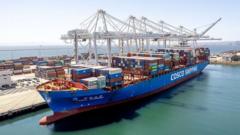In a recent announcement, the US Trade Representative (USTR) outlined plans to impose new port fees on Chinese ships, aiming to bolster the US shipbuilding industry and counter China's maritime dominance. This strategy is part of the broader effort to enhance domestic production capabilities, amidst concerns that existing tariffs and trade policies could further disrupt global trade dynamics.
US Announces New Port Fees for Chinese Ships to Boost Domestic Shipbuilding

US Announces New Port Fees for Chinese Ships to Boost Domestic Shipbuilding
As tensions rise over trade relations, the US unveils a fee plan targeting Chinese vessels in a move to revive American shipbuilding.
The USTR revealed that the fees will begin in 180 days, with a progressive increase planned thereafter. Initially, ship owners from China will incur charges based on the weight of their cargo, with fees starting at $50 per ton for bulk vessels and $18 per ton for container ships. Non-US built cars transported via ships will incur a fee of $150 per vehicle. The plan reportedly seeks to reduce reliance on imports while addressing the competitive disadvantages faced by American businesses.
Critics warn that these measures, combined with existing tariffs, could have significant implications for global trade. As ships originally bound for US ports redirect to European destinations, American consumers may bear the brunt of increased prices. The announcement coincides with broader changes in global shipping patterns, as businesses adapt to the evolving trade landscape wrought by tariff impositions and port congestion issues across Europe.
Experts note that the US tariffs on Chinese goods could potentially rise as high as 245% when combined with existing taxes. As a result, there has been a marked increase in container traffic to the UK and the EU, with Chinese imports into those regions climbing substantially in the first quarter of 2025. Industry analysts predict ongoing disruptions, prompting shifts in supply chains and trade routes as companies explore alternative markets to mitigate costs and avoid escalating fees associated with US ports.
Critics warn that these measures, combined with existing tariffs, could have significant implications for global trade. As ships originally bound for US ports redirect to European destinations, American consumers may bear the brunt of increased prices. The announcement coincides with broader changes in global shipping patterns, as businesses adapt to the evolving trade landscape wrought by tariff impositions and port congestion issues across Europe.
Experts note that the US tariffs on Chinese goods could potentially rise as high as 245% when combined with existing taxes. As a result, there has been a marked increase in container traffic to the UK and the EU, with Chinese imports into those regions climbing substantially in the first quarter of 2025. Industry analysts predict ongoing disruptions, prompting shifts in supply chains and trade routes as companies explore alternative markets to mitigate costs and avoid escalating fees associated with US ports.






















